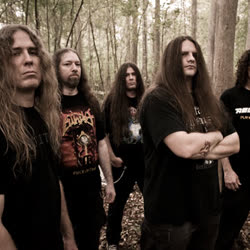The Live Challenges Facing Cannibal Corpse
Cannibal Corpse release new album, A Skeletal Domain, which stays true to the bands signature sound.

Cannibal Corpse

Most musicians mellow with age – not death metal legends Cannibal Corpse. On album number 13, A Skeletal Domain, you’ll find ditties titled Icepick Lobotomy and Bloodstained Cement that are just as brutal as anything off their 1990 debut, Eaten Back To Life. As bassist Alex Webster notes, why change a winning formula?
“There are plenty of bands out there talking about current events and the fucked-up state of the world – we’ll leave them to it,” he laughs. “I’ve always viewed Cannibal Corpse as an escape – it’s like watching a brutal horror movie to get away from reality. Our stories are completely fictionalised horror – and I know people say that, ‘Well, fucked-up murders and torture happens in the world’ – and that’s true – but the stories we tell aren’t based on real people. It’s what I’d call dark fantasy – that term sums up our lyrical approach.”
"it’s like watching a brutal horror movie to get away from reality"
Musically speaking Cannibal Corpse has stuck with their tried and true template of blast furnace-strength death metal. That said, Webster is keen to point out some sonic tweaks.
Don't miss a beat with our FREE daily newsletter
“Look, there are no radical differences on this record but there are differences. For one thing there’s a range of writers for the album – myself, Pat, Rob and Paul – which means each individual song has its own character. You won’t get bored listening to the record. There’s also some unexpected solos that people wouldn’t expect from us – some different harmonies – so yeah there’s enough here to keep people interested. That said it all falls within the realm of death metal – so no one has to worry,” he laughs again.
Cannibal Corpse originated in the icy climes of Buffalo, New York, before migrating south to join the nascent Floridian death metal scene centred around Tampa’s Morrisound studio. So does that make Cannibal Corpse a so-called ‘Morrisound’ band – as historians of the genre like to claim?
“I’ve always considered this band as having two homes. We’ll always be from Buffalo, New York. But at the same time the move down to Tampa was a very important one for Cannibal Corpse. We did our first six albums there – four of them before we physically moved there to live. Also we were heavily influenced by bands like Morbid Angel and Death – who were of course both instrumental in the rise of the central Florida death metal scene. So were we part of the scene? Yeah – but also we had those very important formative years in Buffalo so we’re a little bit different to those other bands.”
That Cannibal Corpse remains today an ongoing concern is nothing short of remarkable. Their brutal (even by death metal standards) sound will never be fully accepted by the mainstream and the boys rely heavily on a small yet fanatical fanbase. Webster himself still can’t believe how it’s all gone down.
“If you told me back in 1988 that we’d be still playing in 2014 and going to places like Australia I wouldn’t have believed you. At the time even the most established bands, like Black Sabbath and Iron Maiden hadn’t been around twenty years. The idea of being around for 25 years was unheard of – and we are so thankful to all our fans for their ongoing support.”
Although they no longer have to worry about censorship (the band’s first three records were banned for many years in Germany, while here in Australia Cannibal Corpse records were at one point in the mid-‘90s removed from sale altogether) longevity brings with it a new set of challenges. Foremost is putting together a setlist that will please a rabid fanbase.
"It’s getting more and more difficult with every record"
“It’s getting more and more difficult with every record,” Webster admits. “For one thing we don’t like playing sets that are two hours long – because it’s just too much for people and will bore them to death. Usually 70 to 90 minutes is about right – the set has more impact – but that decision means we have to be really careful about what we play. It’s the old problem – people want to hear the old favourites so we have to do some of them in every show. But on top of that we have new material that has to be included as well – as well as trying to cover all the stuff in between. We have tried to do something off every album in the past but it’s getting to the point now that we just can’t do that. So what we try and do is find short songs from some of the lesser known records so we can really represent every period of the band in our live show.
“We have a great set planned for our Australian tour and we always have a heap of fun down there – so come out and hear some great tunes – we’re looking forward to it.”








